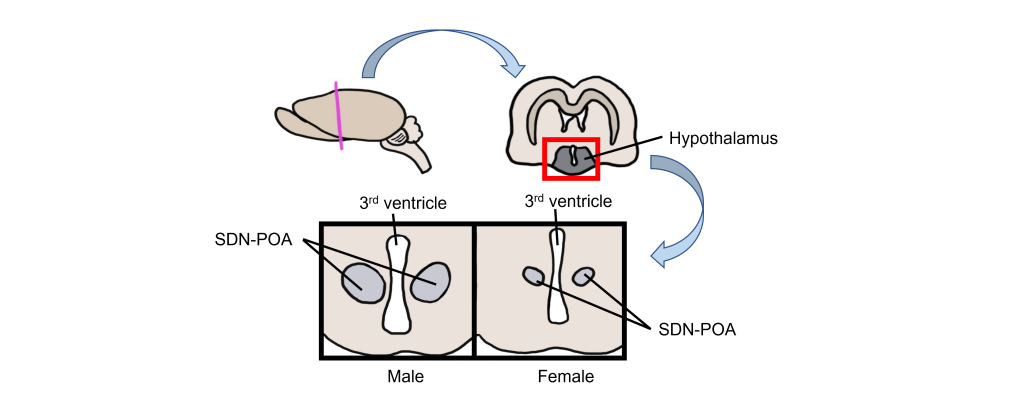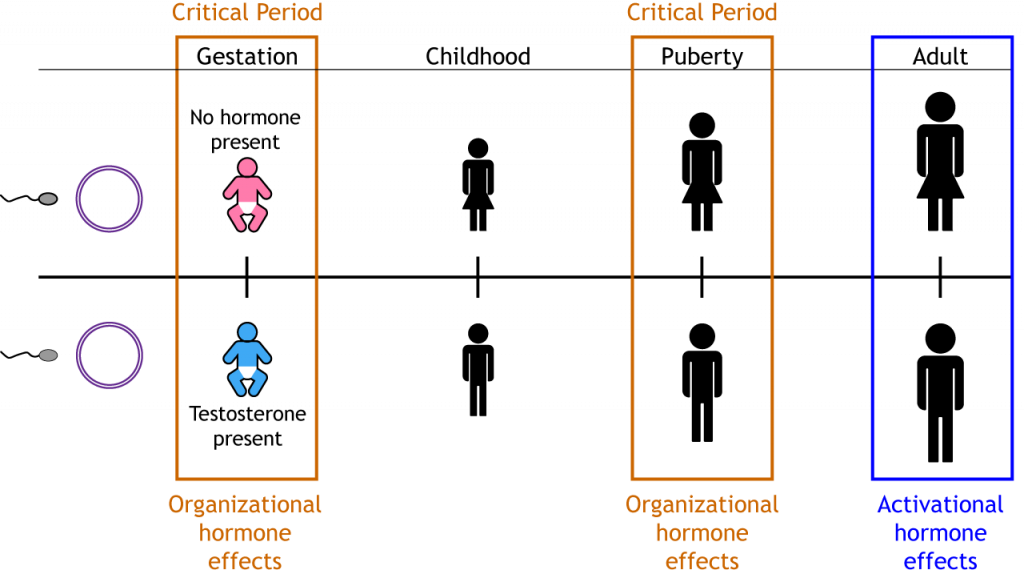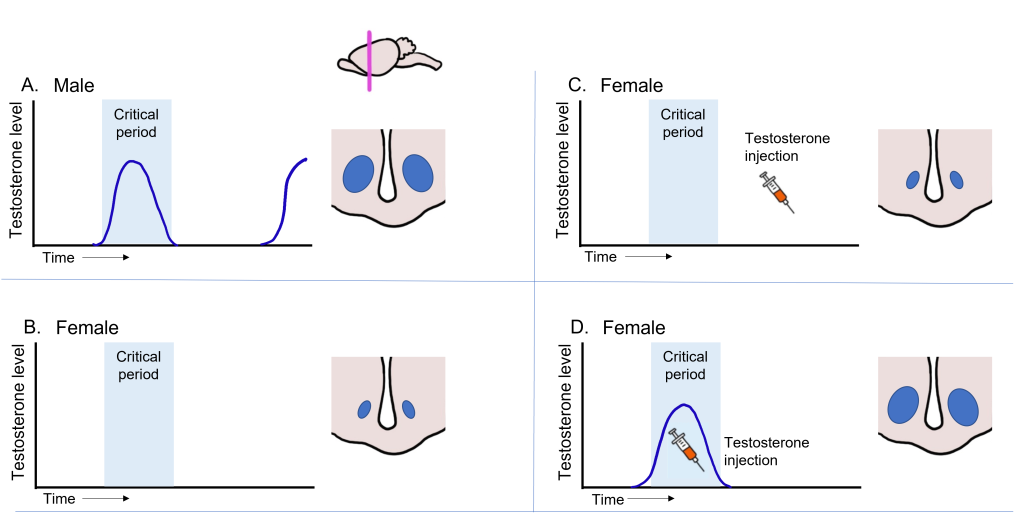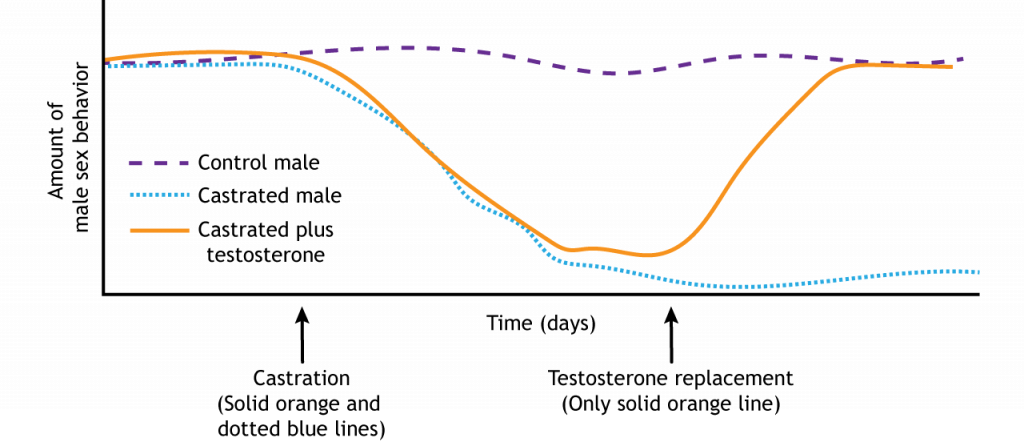54 Organizational and Activational Effects of Steroid Hormones
In addition to differentiating the reproductive duct system, the presence or absence of gonadal steroid hormones during development also differentiates the rest of the body, including the brain. Testosterone causes the brain, body, and behavior of the individual to be masculinized and defeminized. The quiescent ovaries do not release hormones which causes the brain, body, and behavior of the individual to be feminized and demasculinized.

Sexual Dimorphisms
In the brain, gonadal hormones bind to receptors to alter neuronal function and overall behavior. In many species, males and females have different roles in sexual reproduction when it comes to finding a mate, copulation, birth, nursing, and nurturing offspring. It follows that there are differences in structure and function between male and female brains.
A sexual dimorphism is a distinct difference in the size or appearance of a structure between the sexes of an animal. In rodents, a sexual dimorphism has been described in the sexually dimorphic nucleus of the preoptic area (SDN-POA) within the hypothalamus. The SDN-POA is generally 5-8 times larger in male rodents than it is in female rodents.

Are there sexual dimorphisms in the human brain? This answer is not clear. There may be differences in structures, but the differences are small and controversial. A set of nuclei within the human brain has been studied with regard to sexual dimorphisms called the interstitial nuclei of the anterior hypothalamus (INAH). Within this collection of nuclei, INAH-1, INAH-2, and INAH-3 have been reported to be larger in men than in women, with INAH-3 having the largest difference. The function of INAH in sexual behavior is still not well-understood. Importantly, there is a large degree of variability between human brains. This means that even when a sexual dimorphism is observed, it is being observed “on average” across many brains. Within this comparison group, there will be brains that do not show a sexual dimorphism or potentially show the exact opposite difference in size.
Critical Period
The hormonal effects of secreted testosterone on the brain must take place during a specific time in development, called a critical period. Organizational effects of hormones lead to major, generally irreversible, aspects of cell and tissue differentiation. Organizational effects take place during critical periods like prenatal development and puberty.
In adulthood, the same hormones trigger physiological or behavioral responses called activational effects that are reversible and short-lived.

Organizational Effects of Steroid Hormones
The early role of testosterone is an organizational effect and results in a permanent change in the nervous system and therefore behavior. The androgens released by the testes enter cells of the SDN-POA and are converted into estradiol through the actions of the enzyme aromatase. The estradiol within the SDN-POA acts to masculinize the structure of the SDN-POA by preventing cell death, causing the SDN-POA to be larger in males than in females. Due to the female ovaries being inactive during development (do not secrete estradiol), the female SDN-POA has a smaller, feminized structure due to the normal cell death that occurs during development. If testosterone is experimentally administered to a female during the organizational critical period, the SDN-POA will be masculinized and larger, however if the testosterone is experimentally administered to a female after the organizational critical period, the structure of the SDN-POA will remain small and feminized.

Hormone Change in Humans: Organizational Effects
Clearly, the presence of hormones during the organizational critical period is critical for the masculinization of the rodent brain. Below are examples of conditions in humans that demonstrate the organizational effects of gonadal steroid hormones on both the brain and body.
Androgen Insensitivity Syndrome (AIS) (also known as Testicular Feminization Syndrome) affects the development of the reproductive organs. Individuals with this syndrome do not have functional androgen receptors. Therefore, circulating androgens cannot bind to androgen receptors which affects the development of secondary sexual characteristics, causing these individuals to have a feminized appearance. They have an XY genotype but have genitalia that look female at birth, with the presence of a vagina, but do not have ovaries or a uterus. As a result, they do not menstruate and cannot become pregnant. Due to the presence of the Y chromosome, individuals with AIS have undescended, but typically functional testes. Many XY individuals that have AIS only discover their syndrome during puberty when they do not experience their first menses. Upon understanding their biology, many still prefer to call themselves women, dress like women, and choose men as their sexual partners.
Congenital Adrenal Hyperplasia (CAH) affects individuals with an XX genotype. During development, the adrenal glands of these individuals produce an excess of androgens. The higher circulating androgen levels results in masculinization of the external genitalia to varying degrees resulting in intersex conditions with ambiguous genitalia structure. These individuals still have ovaries and do not have testes (due to the lack of Y chromosome). In many cases, these individuals are treated medically with hormones and raised as female.
Lastly, a group of individuals in the Dominican Republic referred to as the “Guevedoces” are XY genotypic individuals that are born with a feminized appearance and undescended testes that are assigned a female sex at birth. These individuals have a deficiency in the activity of the enzyme 5-α-reductase. 5-α-reductase is typically responsible for converting testosterone into dihydrotestosterone (DHT), the hormone that is responsible for the development of male external genitalia. However, at puberty there is a surge in testosterone in these individuals that overcomes the 5-α-reductase enzyme deficiency, allowing in the growth of male sex organs. This causes these individuals that were raised as females to start growing a penis. “Guevedoces” literally translates to “penis at 12 years” in Spanish. This phenomenon has also been observed in a small population with Papua New Guinea. Culturally, this has major implications in gender roles for these individuals as only 2 genders are typically recognized, though they are described as a third sex.
Activational Effects of Steroid Hormones
Activational effects of gonadal steroid hormones occur during adulthood and are short-lived and reversible. Examples of activational effects of gonadal steroid hormones include sexual behavior patterns and ovulation. Removal of the activating hormone will cause the behavior to stop, but replacement later will cause the response to begin again because the brain has previously been organized to produce those behaviors when hormones are present. Interestingly, maternal and paternal behavior have both been shown to change the brain in various ways such as changes in dendritic branching and somatosensory maps through experiential plasticity.
The role of activational hormones can be demonstrated by adult castration in male rats. Healthy males with intact testes will show sexual behavior when placed with a female rat. Castration, the removal of the testes, will cause males to stop showing sexual behavior because the activating hormone, testosterone, is no longer present. However, if the castrated males receive testosterone replacement, they will resume showing sexual behavior. The sexual behavior brain circuit was organized during development by exposure to gonadal hormones, and in adulthood that circuit can be activated by testosterone. The adult behavior can only be seen when the activating hormone is present.

Key Takeaways
- Testosterone released from the testes during development masculinizes and defeminizes the brain and body.
- The ovaries do no release hormones during development, causing the default feminized brain and body.
- Sexual dimorphisms are differences in the size or appearance of a structure between males and females.
- Gonadal steroid hormones cause a sexual dimorphisms in the sexually dimorphic nucleus of the preoptic area in male rodents.
- The interstitial nuclei of the anterior hypothalamus might be sexually dimorphic in the human brain, however the differences in size are small and controversial.
- A critical period is a period of time in development where hormones have the most effect in determining the structure and function of the brain and body.
- Organizational effects of gonadal steroid hormones occur early in life during development and result in permanent changes in brain and behavior.
- Activational effects of gonadal steroid hormones occur later in life during adulthood and result in temporary changes in brain and behavior that come and go as hormones levels change.
- Androgen Insensitivity Syndrome is a condition in humans in which XY genotypic individuals have dysfunctional androgen receptors.
- Congenital Adrenal Hyperplasia is a condition in humans in which XX genotypic individuals have excess secretion of androgens during development.
- The Guevedoces of the Dominican Republic are XY genotypic individuals that have deficient activity of the enzyme 5-α-reductase.
Attributions
Portions of this chapter were remixed and revised from the following sources:
- Foundations of Neuroscience by Casey Henley. The original work is licensed under a Creative Commons Attribution-NonCommercial-ShareAlike 4.0 International License
Media Attributions
- Developmental Hormones © Casey Henley is licensed under a CC BY-NC-SA (Attribution NonCommercial ShareAlike) license
- SDN-POA © Valerie Hedges is licensed under a CC BY-NC-SA (Attribution NonCommercial ShareAlike) license
- Organizational vs Activational © Casey Henley is licensed under a CC BY-NC-SA (Attribution NonCommercial ShareAlike) license
- SDN-POA Testosterone © Valerie Hedges is licensed under a CC BY-NC-SA (Attribution NonCommercial ShareAlike) license
- Castration Effects © Casey Henley is licensed under a CC BY-NC-SA (Attribution NonCommercial ShareAlike) license
a difference in the size or appearance of a structure between the sexes of an animal
a window of time where a system has heightened sensitivity to particular stimuli in order to develop properly
Early, generally irreversible, effects of steroid hormones that occur during development
physiological and behavioral responses that are reversible and short-lived, occurring in adulthood
surgical removal of the testes

